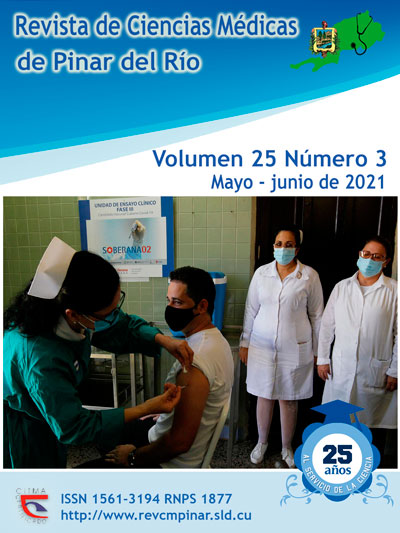Malformation of cleft hand and foot syndrome
Keywords:
PYODERMA GANGRENOSUM/therapy, IMMUNOSUPPRESSION, CYCLOSPORINE, INFLAMMATORY BOWEL DISEASES, GASTROINTESTINAL TRACT.Abstract
Introduction: malformation of cleft hand and foot syndrome is a rare congenital defect with autosomal dominant inheritance pattern, symmetrical in shape.
Case presentation: a three-month-old female infant born at 36 weeks, weighing 2450 grams, height 50 cm, Apgar 8-9, detected at birth median cleft in both hands and feet with ectrodactyly of the 2nd and 3rd fingers of all limbs, no other malformations. The neonatology service of the provincial pediatric hospital requests assessment by clinical genetics that after an exhaustive physical examination leads to the syndromic diagnosis, resulting in the first case in the province.
Conclusions: considering of great value the clinical method to conduct the diagnosis with the help of radiological studies to be able to classify the type of ectrodactyly. The patient is kept with multidisciplinary follow-up by orthopedics, psychologists, physiatrists and clinical geneticist, providing adequate genetic counseling, as well as information on future operations that will improve the functions of her limbs and improve her quality of life.
Downloads
References
1. Gane BD, Natarajan P. Split-hand/feet malformation: A rare syndrome. J Family Med Prim Care. [Internet]. 2016 Jan-Mar; [citado 03/04/2020] 5(1):168-9. Disponible en: https://www.jfmpc.com/article.asp?issn=2249-4863;year=2016;volume=5;issue=1;spage=168;epage=169;aulast=Gane
2. Khan A, Wang R, Han S, Umair M, Alshabeeb MA, Ansar M, et al. A Novel Homozygous Nonsense Mutation p.Cys366* in the WNT10B Gene Underlying Split-Hand/Split Foot Malformation in a Consanguineous Pakistani Family. Front Pediatr. [Internet]. 2020 Jan 9; [citado 03/04/2020] 7:526. Disponible en: https://www.frontiersin.org/articles/10.3389/fped.2019.00526/full
3. Zhuo Z, Zhai Y, Jin P, Yan W, Kong H, Fang X, et al. Identification of pathogenic mutation in a Chinese pedigree affected with split hand/split foot malformation. Zhonghua Yi Xue Yi Chuan Xue Za Zhi. [Internet]. 2018 Dec 10; [citado 03/04/2020] 35(6):808-811. Disponible en: https://www.ncbi.nlm.nih.gov/pubmed/30512151.
4. Ullah A, Gul A, Umair M, Irfanullah, Ahmad F, Aziz A, et al. Homozygous sequence variants in the WNT10B gene underlie split hand/foot malformation. Genet Mol Biol. [Internet]. 2018 Jan-Mar; [citado 03/04/2020] 41(1):1-8.Disponible en: https://www.ncbi.nlm.nih.gov/pubmed/29384555.
5. Umair M, Ullah A, Abbas S, Ahmad F, Basit S, Ahmad W. First direct evidence of involvement of a homozygous loss-of-function variant in the EPS15L1 gene underlying split-hand/split-foot malformation. Clin Genet. [Internet]. 2018 Mar; [citado 03/04/2020] 93(3):699-702.Disponible en: https://www.ncbi.nlm.nih.gov/pubmed/29023680.
6. He W, Lin G, Liang P, Cheng D, Hu X, Zhou L, et al. Genetic analysis of three families affected with split-hand/split-foot malformation. Zhonghua Yi Xue Yi Chuan Xue Za Zhi. [Internet]. 2017 Aug 10; [citado 03/04/2020] 34(4):476-480. Disponible en: https://www.ncbi.nlm.nih.gov/pubmed/28777841.
7. Lango Allen H, Caswell R, Xie W, Xu X, Wragg C, Turnpenny PD, et al. Next generation sequencing of chromosomal rearrangements in patients with split-hand/split-foot malformation provides evidence for DYNC1I1 exonic enhancers of DLX5/6 expression in humans. J Med Genet. [Internet]. 2014 Apr; [citado 03/04/2020] 51(4):264-7. Disponible en: https://www.ncbi.nlm.nih.gov/pubmed/24459211.
8. Tayebi N, Jamsheer A, Flöttmann R, Sowinska-Seidler A, Doelken SC, Oehl-Jaschkowitz B, et al. Deletions of exons with regulatory activity at the DYNC1I1 locus are associated with split-hand/split-foot malformation: array CGH screening of 134 unrelated families. Orphanet J Rare Dis. [Internet]. 2014 Jul 29; [citado 03/04/2020] 9:108. Disponible en: https://www.ncbi.nlm.nih.gov/pubmed/25231166.
9. Liu Y, Huang Y, Yang W, Zhang X. Identification of a pathogenic microduplication in a Chinese split-hand/split-foot malformation family. Zhonghua Yi Xue Yi Chuan Xue Za Zhi. [Internet]. 2014 Jun; [citado 03/04/2020] 31(3):276-9. Disponible en: https://www.ncbi.nlm.nih.gov/pubmed/24928001
10. Rattanasopha S, Tongkobpetch S, Srichomthong C, Kitidumrongsook P, Suphapeetiporn K, Shotelersuk V. Absent expression of the osteoblast-specific maternally imprinted genes, DLX5 and DLX6, causes split hand/split foot malformation type I. J Med Genet. [Internet]. 2014 Dec; [citado 03/04/2020] 51(12):817-23. Disponible en: https://www.ncbi.nlm.nih.gov/pubmed/25332435.
Downloads
Published
How to Cite
Issue
Section
License
Authors who have publications with this journal agree to the following terms: Authors will retain their copyrights and grant the journal the right of first publication of their work, which will be publication of their work, which will be simultaneously subject to the Creative Commons Attribution License (CC-BY-NC 4.0) that allows third parties to share the work as long as its author and first publication in this journal are indicated.
Authors may adopt other non-exclusive license agreements for distribution of the published version of the work (e.g.: deposit it in an institutional telematic archive or publish it in a volume). Likewise, and according to the recommendations of the Medical Sciences Editorial (ECIMED), authors must declare in each article their contribution according to the CRediT taxonomy (contributor roles). This taxonomy includes 14 roles, which can be used to represent the tasks typically performed by contributors in scientific academic production. It should be consulted in monograph) whenever initial publication in this journal is indicated. Authors are allowed and encouraged to disseminate their work through the Internet (e.g., in institutional telematic archives or on their web page) before and during the submission process, which may produce interesting exchanges and increase citations of the published work. (See The effect of open access). https://casrai.org/credit/



